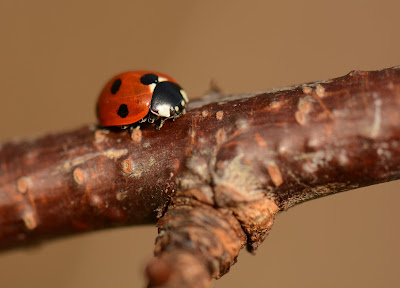With another day of sunshine and an afternoon free
I ventured over to Quinta arboretum and
wildlife trust reserve, and also the nearby Swettenham meadows. Temperatures
were suddenly considerably milder and with this, the insects which have overwintered
as adults, were becoming increasingly visible. After a busy weekend of bird ringing
and some Barn Owl box repairs (a post for another time perhaps), it was enjoyable
just to relax and enjoy the peace and quiet in the sun. Driving home the day previous
I’d seen a butterfly - large, dark and strong-flying I suspect it was a Peacock
(though a Red Admiral which are increasingly surviving our milder winters would
be another possibility) - ID-ing a butterfly whilst driving is, admittedly, not
the best way to do it! Another first for the year that weekend had been a large
queen Buff-tailed bumblebee, so it was with these invertebrates in mind that I
included Swettenham meadows in my wanderings.
Hoverflies which overwinter as adults have been tempted from their winter slumber and several individuals of the species Eristalis pertinax were basking in the sunlight on benches and branches, the one below a female (apparent from the spacing between the eyes, male hoverflies having eyes which meet together as a general rule) on a branch encrusted with common orange lichen (Xanthoria parietina).
 |
| Female hoverfly Eristalis pertinax |
 |
| Male dung fly |
Another splash of colour was found in the purpley-pink flowers of common lungwort, a pretty wildflower which blooms in late winter/early spring and is quite disctinctive with its silver spotted leaves. The plant has historically been used in herbal medicine as a treatment for various lung/respiratory conditions, originally because of the leaves' supposed resemblance to a diseased lung, hence its common name and also its latin name of Pulmonaria officinalis.
 |
| Flowers of Common Lungwort |
 |
| 7-spot ladybird |
 |
| The buff 'tail' of a queen Buff-tailed bumblebee |
This particular individual was quite happy to sit still but with her head pushed into the grass - fine for identification but perhaps not so good for photography! As with many other insects, without sudden movements they are often quite tolerant of close-up photography, of course being respectful of the fact that they can sting. Unlike honey bees bumblebees can sting more than once and it is only the females that can sting. In several years of getting very close to them, I have never (at least not yet anyway!), been stung.
Having seen a fleeting glimpse of a butterfly the previous day, I was keen to see if I could find any more which had been tempted from hibernation so I made the short walk between Quinta arboretum and Swettenham meadows, an excellent place locally for butterflies. (In the UK most butterflies overwinter as either a caterpillar or chrysalis but a handful hibernate as adults - Brimstone, Comma, Small Tortoiseshell, Peacock and increasingly with milder winters, Red Admirals.) Alas it was not meant to be, and another buff-tailed bumblebee was my only invertebrate sighting of note.
These are Oak Marble Galls induced by the gall wasp Andricus kollari, a very small and stumpy parasitic wasp. These wasps have two quite different generations which complete their lifecycle, an asexual generation composed entirely of females and a sexual generation of males and females. Mated females of the sexual generation lay their eggs in the developing leaf buds of native oak trees, chemicals produced by the larvae cause this distortion of the buds. These galls provide a safe home to the developing agamic (asexual) females. The mature agamic wasps then leave in the autumn - you can clearly see the exit holes in the galls in this photo. This generation of wasps will then go on to lay their eggs in the buds of Turkey oak where the sexual generation of males and females develop in tiny egg-shaped galls, completing their complex lifecycle.
 |
| Oak Marble galls |
Trees were showing their readiness for the new spring with catkins - the cylindrical flower clusters produced by several types of tree, forming along the branches. Now admittedly my tree identification skills are pretty poor at the best of times, even more so when trees are leafless but I think that these are the male catkins (also sometimes called 'lambs' tails) of Hazel. (Unless of course someone tells me they're Birch....?)

Funnily enough we were out, yesterday and we were reminiscing about how Swettenham was our favourite place down in Cheshire. We were at our equivalent place here, Hunters Quarry (which isn't quite as nice though) and also funnily enough saw similar things to you, lots of Eristalis pertinax, buff tailed queen etc.
ReplyDeleteThanks Phil, yes it's great to have Swettenham in the 'local patch'. My only gripe is the endless dog owners that don't feel the 'dogs on leads only' signs apply to them - the reserves/arboretum should be places where people and particularly wildlife don't have to worry about out of control dogs (or what you step in!).
ReplyDeleteWhen we 'discovered' it about 10 years about ago we never saw anyone else - it seemed really special, then we gradually started seeing more people, which slightly detracted from the appeal - yes your dogwalkers and people occupying our picnic spot!
ReplyDelete